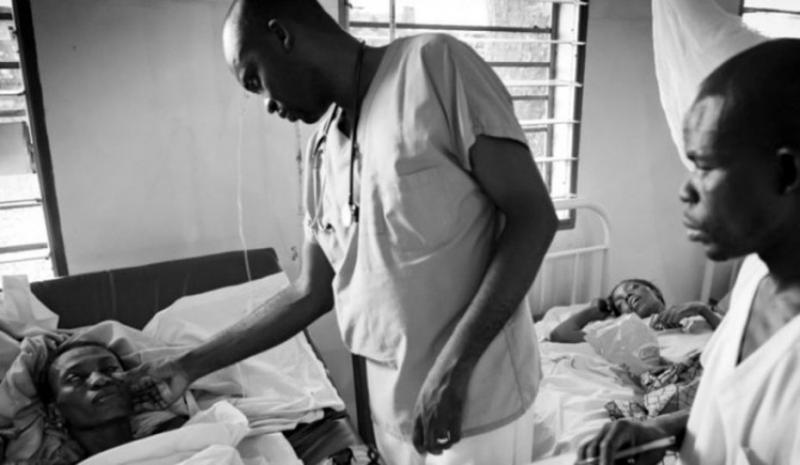
While the 2014 Ebola crisis was raging in West Africa, Gregg Gonsalves, co-director of the Yale Global Health Justice Partnership, gave a sad-but-accurate diagnosis of the state of global health concerns in the U.S. “Exotic infections for Americans, often from far away places, often Africa, strike fear into their hearts,” Gonsalves wrote. ”But only once the pathogens have cleared customs.”
Around the same time, the satirical news outlet The Onion made the same point more bluntly with a story entitled “Experts: Ebola Vaccine at Least 50 White People Away.” The Onion quoted a fictitious Tulane University pathologist saying, “With each passing white person, we’re moving closer to an eventual antigenic that will prevent and possibly even eradicate the disease.”
Sadly, that story was not really a joke. The reason Ebola was so deadly was that no medicines were available to effectively prevent it or to treat it. Yet promising vaccines to prevent Ebola, and drugs to treat it, had been uncovered years before the outbreak, only to languish without further development. They were not developed because pharmaceutical corporations saw no prospect of significant profits to be made on the drugs. The expected need was limited, and those who would benefit were likely to be too poor to pay high prices. The virus had not cleared customs.
As far back as 2003, Ebola researcher Thomas Geisbert recognized the problem, writing with regret that there was “little commercial interest for developing an Ebola virus vaccine.” After the 2014 outbreak began claiming lives by the thousands, Oxford Professor Adrian Hill, who was leading Britain’s response to Ebola, diagnosed the situation in stark terms. “(U)nless there’s a big market, it’s not worth the while of a mega-company . . . There was no business case to make an Ebola vaccine for the people who needed it the most.”
The Ebola vaccine problem holds true even more broadly in our for-profit medicines system. The trillion-dollar-plus global medicines system is designed to direct its rewards to private corporations, and those corporations predictably have no interest in the diseases of those who cannot pay high medicine prices. Private industry accounts for only about 10% of the global research and development investments in diseases of the poor, less than 30% of the drugs newly brought to market bring increased therapeutic value, and the industry spends more on marketing its drugs than on research to develop new ones.
As a result, 400 million people globally go without healthcare, including medicines.
But those are almost solely poor people, people of color, and people who live in places far away from the U.S. The diseases that kill them—tuberculosis, malaria, etc.—largely do not pose significant risks to those of us who are more fortunate. So, as Gregg Gonsalves and The Onion pointed out, for most Americans and others in wealthy nations, the lack of medicines to treat these diseases is not a central concern.
Now, however, the dysfunction of the global medicines system may actually be clearing customs, in the form of antimicrobial resistance, a global health concern that will reach into even the most wealthy of communities.
Antimicrobial resistance occurs when microorganisms such as bacteria and viruses change in ways that make traditional medications used to treat them, including antibiotics, ineffective. Antimicrobial resistance already kills 700,000 people a year, and is projected to kill a stunning 10 million people a year by 2050.
Yet, in the last 25 years, almost no new antibiotics have been developed to address this building crisis. Why? You guessed it: there is not much money to be made. The drugs to fight infections take a long time to develop, and patients don’t take them for lengthy periods. As the United Nations High-Level Panel on Access to Medicines recently wrote, new antibiotics could save millions of lives, but expensive development and a lack of lengthy prescription period “limit the market potential and curtails profits.” Big Pharma is not interested.
The World Health Organization and others are working on plans to address the lack of new medicines being developed for microbial resistance, but the UN High-Level Panel openly worries about those plans being “adequately resourced.”
Under our current system, cures for male pattern baldness, erectile dysfunction, or cosmetic drugs have no trouble being “adequately resourced.” But, as the families of 11,000 Ebola victims can tell us, this system is not designed to address killing outbreaks when there is not a big profit to be made. Let’s hope the prospects of millions dying from resistant infections, especially when those infections will decidedly clear customs into the U.S., will cause the system to change.
To sign up to receive our weekly "Prescription for Change" blog posts, please click here.
